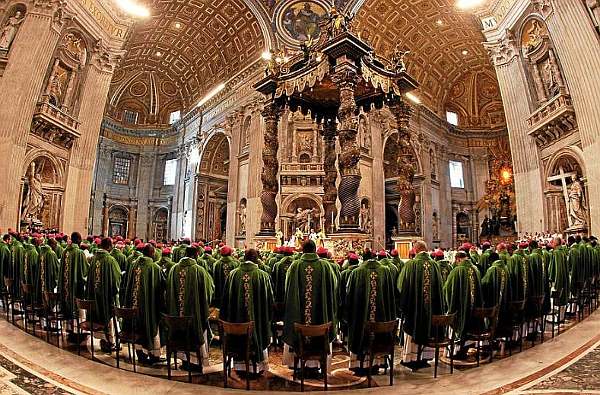I går starta en synode om Afrika i Vatikanet, og bildet viser alle biskopene som deltok i messen i Peterskirken søndag morgen. Synoden skal vare fram til 25. oktober, og John Allen skriver slik om gårsdagen:

Pope Benedict XVI led this morning’s liturgy, joined by almost 240 bishops, most of them Africans taking part in the synod. Concelebrating the Mass were the three co-presidents of the synod, Cardinals Francis Arinze of Nigeria, Wilfrid Fox Napier of South Africa, and Theodore-Adrien Sarr of Senegal, along with Cardinal Peter Turkson of Ghana, the “relator,” or general secretary, of the synod.
If the musical tone was upbeat, Pope Benedict struck a more sober note in his homily this morning. The pope praised the dynamism of the faith in Africa, where the Catholic population grew during the second half of the twentieth century by some 7,000 percent, soaring from 1.9 million Catholics to an estimated 160 million today.
The pope called Africa “an immense spiritual ‘lung,’ for a humanity that appears to be in a crisis of faith and hope.” Later, during his midday Angelus address, Benedict praised the «extraordinary human wealth» of Africa.
Nonetheless, in his homily Benedict warned that Africa faces two serious threats, suggesting that the synod should carefully ponder responses to both.
The first threat, Benedict said, is a “practical materialism, combined with relativistic and nihilistic thought.” Those philosophical currents, he suggested, are reaching Africa from the West.
“The so-called ‘first world’ has exported and is still exporting its toxic spiritual refuse,” the pope said, “which infect the populations of other continents, especially in Africa.”
“Colonialism is finished in a political sense,” the pope said, “but it’s not completely gone away.”
The second threat Benedict identified is “religious fundamentalism, mixed with political and economic interests.”
“Groups with diverse religious affiliations are spreading themselves throughout the African continent,” the pope said. “They do so in the name of God, but according to a logic opposed to that which is divine. They’re not teaching and practicing love and respect for liberty, but intolerance and violence.”
The pope also made clear reference to the social ills that continue to scar Africa, citing “exploitation, conflicts and corruption,” as well as “poverty, injustices, violence and wars.” He called upon the church in Africa to be a source of “prophecy and ferment of reconciliation among the various ethnic, linguistic and religious groups, within individual nations and across the entire continent.”
In his Angelus remarks, Benedict likewise noted that life in Africa is marred by «so much poverty, and still suffers under heavy injustices.» … …



